
A Souped-Up Super ZZT World
Tyrobain doesn't have to do even a fraction of what it does nor does it even have to do it all that well. Compared to ZZT, the number of released Super ZZT worlds is dire, for quite a number of reasons. Its editor is hidden. Its editor isn't nearly as polished as ZZT's. In many ways its even more limited than its older sibling. The boards are bigger, 7680 tiles compared to ZZT's 1500, and yet you're still limited to the same 20,000 bytes of memory. There's been an entire Campaign Against SZZT. Making a good ZZT game is a challenge, but making a good Super ZZT game seems to have been outright impossible.
But perhaps that's because folks were looking at it from the wrong perspective. Super ZZT has a myriad of issues (many of which have been lifted with the advent of source ports like ClassicZoo, but it does offer design constraints that are different from ZZT, allowing it to still do things the original simply can't. Maybe the trouble is simply approaching Super ZZT game design from the same angle one would approach ZZT. The limited visibility restricts artwork, but works great when delving into dungeons. ZZT is notable in that all code lives on the board. If you're lucky you can hide it in the surrounding space, but often you'll wind seeing tiles flash, or seeing preposterous techniques as code is converted to physical elements before being converted back. To put it generously, Super ZZT gracefully allows the camera to keep the player from seeing backstage, letting programmed interactions come off as natural as collecting ammo and shooting it at the nearest ruffian. To put it less generously, Super ZZT lets you shove a hideous mess into a corner and keep it out of frame.
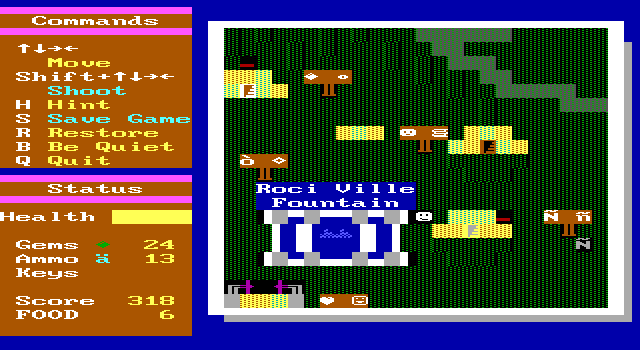
In 2016, an author by the name of 8x14 quietly released a Super ZZT game known as Tyrobain into the wild. It was released on a personal website and was neither published to the then fledgling Museum of ZZT nor to the decrepit z2 archive. Its author working from outside any major ZZT community and certainly any Super ZZT community. With its release, suddenly, after nearly twenty-five years, Super ZZT finally had its system seller. Something you could point to and not just say it's a fun little game, but a showstopper that exemplifies the medium in ways none before (and as of writing, none since) have achieved. Alas, to the ZZTers still hanging around, it went entirely under the radar.
I don't like playing favorites, but when you look for well-regarded Super ZZT worlds, the pickings are slim, and even the works by top-tier authors such as the likes of Chris Jong with The Long Voyage series or Alexis Janson with her own House of Horrors, you'll find that they are still overshadowed by their mainstay offerings created for classic ZZT. 8x14's success with Super ZZT isn't merely because there's no ZZT worlds to compare it to. The decades-long drought of releases has meant that Super ZZT worlds always felt like they were designed to be early 90s ZZT worlds. While what was expected to make a good ZZT game constantly evolved over the years (for better or for worse), Super ZZT design has been in stasis. Tyrobain rapidly brings the engine to the present. It does so while skipping over the various growing pains that the ZZT community went through: the rejection of built-ins, the expectation of a story that's either dead-serious or completely absurd, and the idea that these games will be of no interest to those who aren't making such games themselves.
Tyrobain lets you fill in the blank history of Super ZZT far more rosily, resulting in what at first seems to be a retro homage, expanding in complexity as the game progresses to something that can both impress those with that secret understanding of the rules and restrictions of (Super) ZZT-OOP and endear those who are simply seeing system after system introduced and, thanks to its author's understanding of games as a vehicle to deliver emotions to their players, succeeding at doing so every time.
Orin Vs. The Ruffians And Beyond
There's a distinct Dungeons and Dragons vibe throughout Tyrobain that one might dismiss as just "Fantasy = DnD", but there's more to it than merely the core setting. Your adventure in the land of Tyrobain follows the escalation of threats one might expect from tabletop. It starts out with the peace being disturbed as ruffians invade the land with tigers, constructing a fortress, and amassing forces to conquer... a tiny village. Isn't that always how it begins though? Much like a group of new players have to learn the ropes with a simple and comparatively low-stakes scenario, 8x14's initial quest to do something about the ruffians, who call themselves the Scrags, is also a graceful introduction.
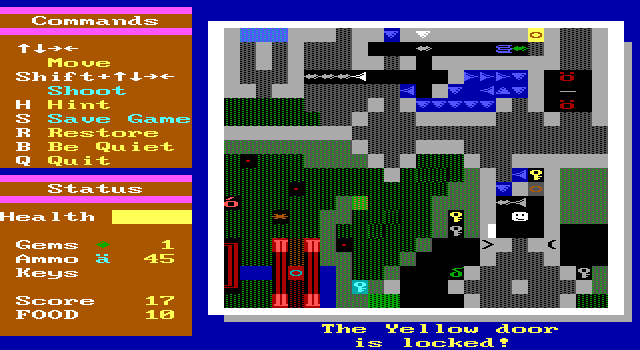
At the start of Tyobain you're playing what could be a Super ZZT world from the early 90s, perhaps with a bit of polish in its presentation. By the limited volume of Super ZZT releases out there, that's really all it takes to be noteworthy. Were that all there was to Tyobain, it would still be a fun adventure, just one whose best ZZT counterpart would be Beth Daggert's Ezanya. Ezanya's own fantasy adventure was certainly impressive in 1992, but Tyrobain is here to stand tall and proud with ZZT titles released nearly twenty-five years later.
As with any good campaign, the introductory chapter is merely the first step, letting the party of one get their bearings in this new world, begin to understand its structure and mechanics, with plenty of inaccessible areas teased on the outskirts of what the game's camera makes visible. On a simple trip to speak with the queen to be given your quest to save the kingdom you'll catch a glimpse of the Black Grove, waterfall-sourced lake, a hedge-maze, the decrepit Castle Drepsake, and Roci Ville. I've frequently praised ZZT worlds that divide their boards up in such a way that the player gets these brief moments where they wonder how they'll arrive at a location and for what purpose. Super ZZT excels at it. All these locations are just on the first board!
ZZT and Super ZZT's ability for boards to connect to any board, euclidean or otherwise, is a feature whose subtle nature means it's one often ignored. You can perhaps ponder how Town's "Rube Board" connects the palace to the final cave, but more likely you'll find it used to create miserable mazes. In Super ZZT, making a board connect with itself is instead the source of a simple but effective illusion. The significantly larger board dimensions combined with the limited viewport can make it quite possible to get disoriented on the very same board! Tyrobain uses looping connections brilliantly, letting the player feel as if these already large boards are gargantuan. It's not uncommon to navigate by landmark and eventually realize you've been taking longer and potentially more dangerous trips to get from point A to point B than necessary.
As the story develops, of course so do the obstacles. Roci Village isn't the only town in danger, and things escalate upon the realization that the Scrags have already begun to lay siege to the goblin town of Nilbog. The only hope is to send in raccoonian soldiers, but to do that requires lighting a distress beacon on Signal Tower. Of course, that requires the use of a magma orb, a now-rare item thought to be located in Mt. Brim.

By the end of the game you're traveling into the Monochasm to save the kingdom and perhaps the world itself from complete destruction. Things escalate neatly and sensibly, and at times the game's primary protagonist Orin will take a backseat to another group of experienced adventurers to get things done. Cooperation and uniting against a common foe is a major theme of the game. The relations between the various races living within Tyrobain are all shown to be pretty friendly, with each bringing their own skills and knowledge to defeat Zovile and his forces. The burden of Tyrobain's fate isn't shouldered alone, with many denizens of the kingdom stepping up to do what must be done to save friends, family, and neighbors.
Xepic Jargon
As a fantasy game, 8x14 doesn't hold back on introducing new terminology and concepts throughout the adventure. The game's spelling, grammar, and frankly quality of writing are all just fine. Run it through a spellchecker and your computer may go up in smoke from the sheer number of words the game invents for itself. The inhabitants are numerous, the named characters go beyond just the major players, with only the least important NPCs being assigned generic titles along the lines of "Rattian Boy" or "Old Goblin". Locations are no different, with even the briefest of travels being assigned a label on any would-be map of the kingdom. With the people, this is merely an opportunity to invent some fun names. (A raccoonian trader named "Jourt", who was then lovingly and endlessly called "jorts", was by far the crowd favorite when this game was streamed.)
People
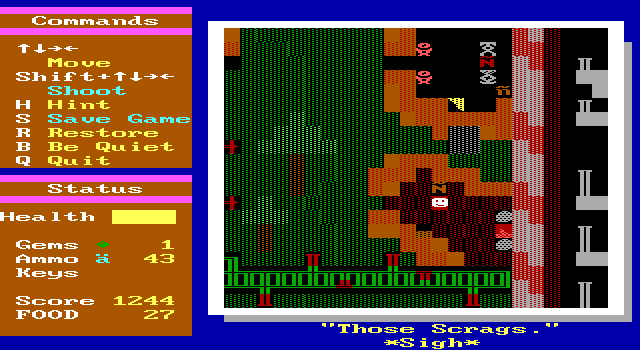
Scrags - The ruffian invaders of Tyrobain. Fond of keeping tigers as pets.
Goblins - Residents of Nilbog. Despite what you might expect from other fantasy games, they're helpful allies to the end.
Raccoonians - The dominant species of Tyrobain. These raccoon-folk have a lot of important information to share, and run most of the shops you'll run into throughout the game.
Rattians - Rat-people who do not in fact make all of the rules. After suffering major losses trying to defend the goblin village, they fear that their town will be the next target of the Scrags, and that they will not be able to fend off the invasion.
Corvus - Crow-folks who don't get their fair share of time in the spotlight. They do like half-and-half though!
Orin - A humble villager living in the grasslands tasked with finding a way to save Tyrobain from the Scrags. Protagonist for much of the game.
Queen Rocceem - Monarch of the raccoonians. She knows the secret to defeating Zovile.
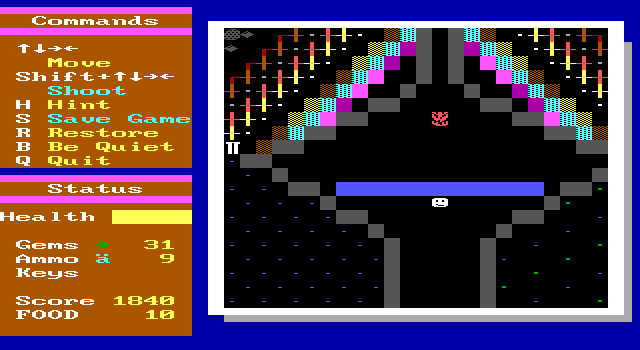
Zovile - Genocidal megalomaniac that controls the Scrags and wishes to destroy Tyrobain and rebuild it in his own twisted image. (A.K.A. The bad guy.)
Zetta - A goblin girl who has fled from her home after it was laid siege by the Scrags. Initially suspicious of Orin upon being discovered, she becomes willing to fight once she believes there is hope yet for her people.
Tain - An elderly raccoonian whose farm was destroyed by the Scrag Ruffians. Tain is in possession of a Holy Orb whose wielder's weapons will then be capable of damaging dark beasts.
Grimpak - A scholar who will share knowledge of xepics with the party.
Arcs, Syla, Lena, Weef - The other adventuring party! This crew brings knowledge of combat, magic, and dealing with traps, and are a formidable bunch.
Truthfully, the number of characters and terminology can be a bit overwhelming. Despite the overworld's size, the game is fairly linear, so if you aren't paying close attention you can still just enjoy the ride and get through it without issue. It's just a little easy to forget where you're actually headed at any given moment. Beware of playing this game in chunks too far apart, as in my original playthrough I completely missed that the second party is indeed a whole new set of characters to play as, mistaking them for Orin, Zetta, and Tain.
Places
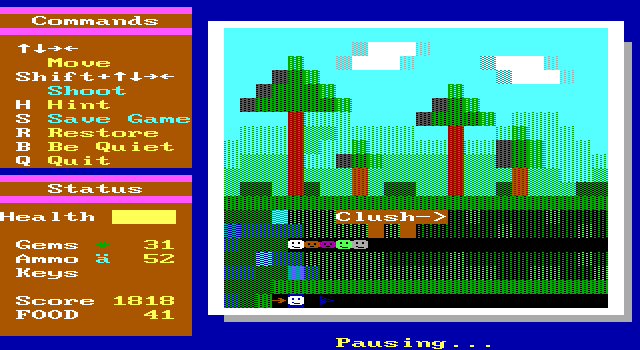
Were I to actually list them all, we'd be here all day. You'll visit the Torrent Islets, Mt. Brim, Sly Cave, Torrent Cavern, Nilbog, Aktar Woods, Dungeon Zextar, Dungeon Sale, the Tower of Dratar, and save the world from utter annihilation in the Monochasm. There's the Rattian village of Rakes. The Covus can be found in the Treehouse of Dimble. The Atkar Woods are transformed into the Atkar Matrix! Castle Drepsake looms to the east. The sheer number of named points of interest is some of the most dense I have ever seen in a (Super) ZZT game before.
Don't let that scare you away. Backtracking almost never happens, and when it does it's usually quite clear what's changed (like being able to walk on water thanks to some swag boots). If Tyrobain seems a bit overwhelming at first, using Super ZZT's hint feature accessed by pressing "H" can provide information on where you are, what's nearby, and (by tracking flags) what you need to be doing next. Strangely this feature doesn't actually last with later boards using it solely for displaying an inventory and letting you eat any food you've collected to restore health. The game does get significantly more straight-forward as your progress so while the feature quietly vanishing is a small detriment, the loss isn't really felt.
Vareyous Othyr Thinges
One thing 8x14 does seem to be a fan of is shaking up the spelling of various terms to make them read as slightly more fantastic. In my initial stream of the game I summed it up as being the sort of game that would spell magic with a "k" added at the end. I'm totally down for this, as each time it happened I always had fun giving those words a more enunciated flair. Magic comes in the form of "Xepics". Spells can be fire, water, air, earth, or thunder based. A pretty standard set of "elementles". Passing a wall of ice requires a "pic-axe". It's all a nice little touch that adds a bit of easy flavoring to the world's design.
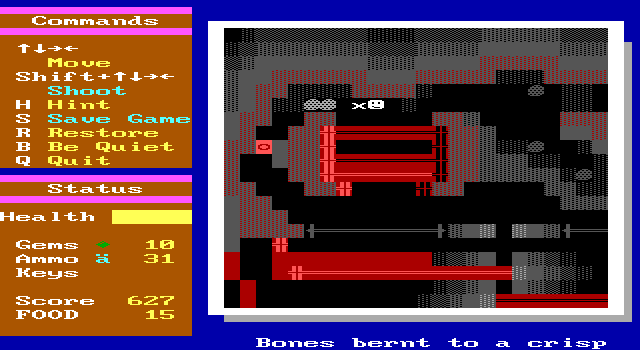
I can totally see this bugging somebody as being pointless flowerization of language as opposed to developing the tone of the world by more involved means. If your reaction to these terms is more negative than neutral, don't let it ruin the game for you, but be aware you're going to be in the thicke of it. You would be making a big mistake to abandyn Tyrobain over such embelyshmxnts. (Okay, okay, I'll stop xis post-hayste.)
Engine-uity
From start to finish it's hard to not be completely charmed by Tyrobain. It really comes together in all aspects to make a game that's truly great, but while you'll get a chuckle from the silly character names or a bit of terror as the dead spring back to life in an ancient pyramid, where Tyobain really becomes its own unique experience is in the sheer number of engines 8x14 has put together. Things may start in a similar vein as Ezanya, but by the end of it a more apt comparison would be to coolzx's A Dwarvish-Mead Dream. Gameplay styles change frequently, especially as both the party and danger grow. While coolzx was able to constantly mix things up on the player, the game style always stuck to the expected style of a fantasy adventure (barring the one futuristic section). Tyrobain takes it one step further, with the game's genre changing wildly. Yes, you are always playing the role of Orin in the kingdom of Tyrobain. What will change, though, is exactly how you explore that kingdom.
Just as with the story things escalate. Initial dungeon crawls are what you would expect and come as no surprise. The large board sizes combined with a limited view, but not as limited as ZZT's torchlight system will immediately have you wondering why it took so long for anybody to put up with Super ZZT's own editor long enough to make a dungeon crawler. These early dungeons fit right into the well-established genre on the ZZT side of things. Narrow hallways, a character armed with a slingshot, keys to collect and some simple puzzles that like to take advantage of the fact that you can shoot beyond where you can see make for a fun little romp through what ZZT would turn into claustrophobic darkness and managing torches.
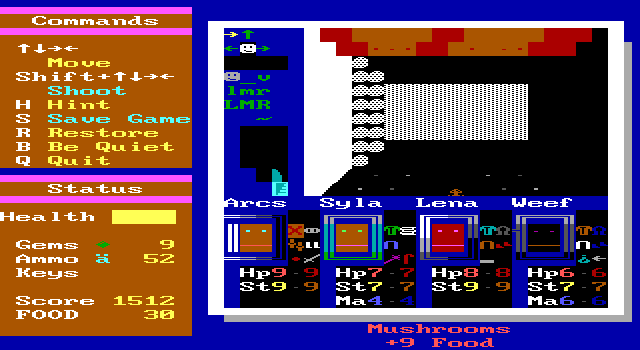
When you step into your first real dungeon, expecting more conventional gameplay only to be dropped into a first person perspective of a maze with your party's stats and items displayed snugly on screen, it's a bit of a shock. Once again Super ZZT pays off, creating a scene that feels like an incredibly clean interface with no wasted space in contrast to engines in ZZT with their massive patches of dark-blue solids shrinking the screen. Super ZZT is already properly scaled for the design, and has benefits still beyond. The first-person maze engine is nothing new to ZZT being used in full games like Darkseekr, and existing at least as far back as Maze 3D from 1996. It's also notoriously bad, but Tyrobain figures out how to manage it surprisingly well.

These engines are always a pain to navigate from the actual first-person view. A lack of texturing on walls, and frequently letting the player only see what is immediately adjacent to them means that you're going to navigate entirely by the map. (A particularly mean-spirited author can go as far as to not let the map be filled in as the maze is explored too!) Later ZZT worlds get a bit better with the draw distance, and 8x14 clearly saw the importance of this. The "navigate by map" is something that would seem a bit trickier to handle. The nuclear option of not letting the player see the map is clearly not worth it, but there needs to be a happy medium, which I believe 8x14 has found here, partially thanks to Super ZZT's own design. In Tyrobain the player normally only sees this first-person view, with the option to reference a map by heading south whenever they like. It all works out rather nicely. The map is approachable, but the switching between map and navigation modes encourage the player to treat the map like an actual map, picking a landmark and devising the route they'll follow once the map has been put away. In this manner the player gets to actually participate in using the engine without having to suffer for it.
The shift from traditional gameplay to this engine based design is one that matches up with the common design philosophy of (Super) ZZT games: learning as you go. Truthfully, I can't believe it's actually that simple, as the level of care in Tyrobain doesn't mesh with the idea that this is just experimental play with Super ZZT. There's too clear an understanding of how things operate, and too much knowledge of more obscure details that a beginner simply wouldn't have. (Such as a lot of the game's text being stored in external files, a space-saving technique that goes unmentioned in any official ZZT documentation.) While it's still not un-imaginable that a game might shift from basic move-and-shoot gameplay to a more complex engine, later additional engines make it pretty clear to me that Tyrobain's author has this all very much planned.
On its own, this first-person navigation doesn't give the full experience of dungeoneering. After all, what fun is slowly moving to your destination if there's nothing to interact with along the way? Previous games have taken a variety of approaches to this. The aforementioned Darkseekr has random encounters that may be treasures, demon patrols with player vs object combat handled on a dedicated board, or merchants looking to make some coin from a desperate adventurer. These are entirely random allowing players a chance to either slowly farm supplies or slowly bleed out depending on their luck and combat prowess.
8x14 takes a simpler approach to how to get into an encounter, by simply placing objects at various cokepoints in the dungeons, making them invisible if the player is to be surprised by them. In addition to combat, Orin and his party will get to pull levers, barter with NPCs, uncover treasures, and get disoriented by walls that move on timers. How 8x14 opted to handle combat is of course the big question. Seeing your party's HP, stamina, and mana points while navigating should probably tip you off to the fact that Tyrobain is hiding RPG battles up its sleeve as well.
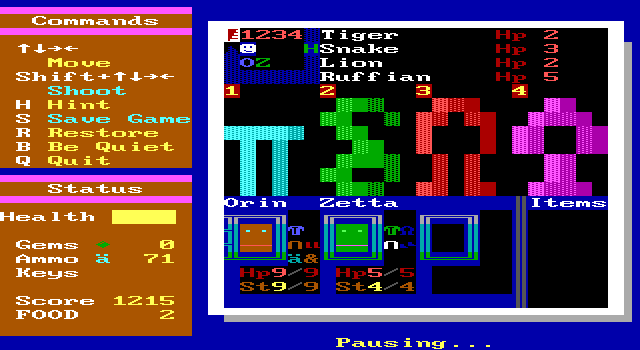
These battles are every bit as charming as the rest of the game, with portraits of your foes on display similar to Defender of Castle Sin, albeit squished into a significantly smaller area. Your early foes feel a bit tongue in cheek, escalating through ZZT and Super ZZT's own bestiary with fights against lions, tigers, snakes (oh my?), rotons, spiders, and even the unfinished pairers. Enemies get a little more original as the encounters go on, and once this starts happening you'll be excited to see what strange beasts you're up against with each new fight. Some fit the standard RPG mold with foes such as slimes, ghosts, or giant wasps. The ones that really shine are the non-ZZT inspired creations. Have you ever fought a Rockpile before? How about Quetzalcoatl? Or, if you're unlucky, you may have a run in with Skeletor!
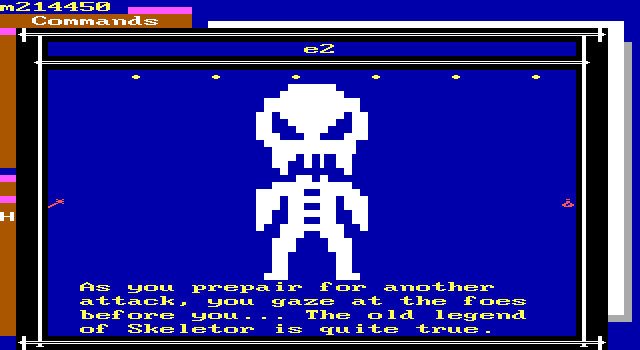
The engine is quite robust, capable of handling a surprisingly numerous amount of combatants, up to four party members versus four monsters, which is almost certainly a record for (Super) ZZT. It's rather involved as well. There's no regressing to basic high-accuracy + low damage or low-accuracy + high damage here. 8x14 should also be commended for avoiding a mountain of pop-ups to navigate. The player element selects a target by touching the number that corresponds to the foe they wish to target and from then on all attacks will be directed to that enemy until you decide to change targets. Physically moving around the board to input commands is usually a detriment to an engine, but with the sheer numbers here it's a far more elegant solution than ever-nesting menus, and it lends itself especially well to the usual strategy of focusing on just one target.
Numbers are kept small, both for the sake of fitting into the limited viewport as well as to make the impact of traded blows apparent. There's no equipment or experience systems here so the stats you bring into the first RPG encounter are the same as the last. Only enemies can break into the double digits for health here. Attacks either hit or miss and do set damage when they land. Things get a bit more interesting with the stamina points each party member has. Taking an action reduces a character's stamina points by one, and if you run out that character is no longer able to attack, becoming effectively nothing more than a meat shield for the still active party members. Early on this isn't really a concern, and the simplicity of the early fights can lead to a false belief that these fights are all just theatrics whose outcomes are predetermined. Later on though, keeping an eye on stamina and health is equally important, with two characters capable of using magical spells known as Xepics.
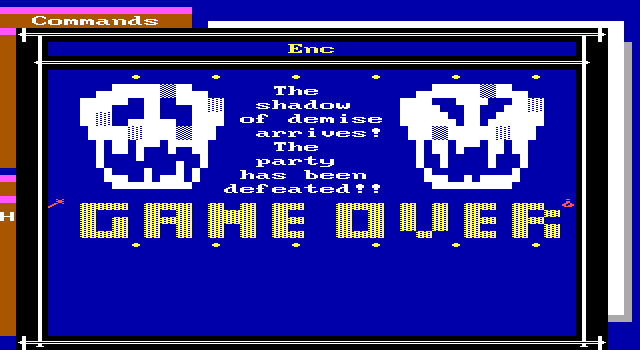
The Xepics are how Tyrobain does implement a form of character progression. New spells will be learned after most encounters, and it's here where 8x14 demonstrates an understand of how to make a good traditional (Super) ZZT RPG that may even put the esteemed Psychic Solar War Adventure to shame. Spells in ZZT RPGs also fall into a bit of a rut, usually just being highly damaging attacks with a limit to how often they can be used. Sometimes, there might be a spell to restore health. Usually though they're nukes to end fights as quickly as possible. Because Tyrobain deals with so many combatants, it's in a unique position to implement spells that deal with status effects. You'll be able to slow enemies, protect party members, petrify a foe, bless a party member, cure poison, as well as restore health/stamina to a party member. Not all enemies are vulnerable to all status effects, and the amount of turns you can waste by choosing incorrectly is pretty thin so it's important to figure out an optimal strategy fast.
Luckily, even if you do fail, the pace of the battles is refreshingly quick compared to the era of the forced "active-time-battle" style of ZZT RPG engines you'd find in the late 90s and early 2000s. The brisk pace, surprisingly strategic decisions to be made, and straightforward interfaces all work in tandem to make Tyrobain's RPG engine perhaps the best one yet. I would love to see if it's possible to mix-and-match elements from this one with the reusable random encounters from Psychic Solar War Adventure. Effectively doing so could very well lead to a role-playing game that finally could compete with the 16-bit RPGs that inspired a generation of ZZTers growing up.
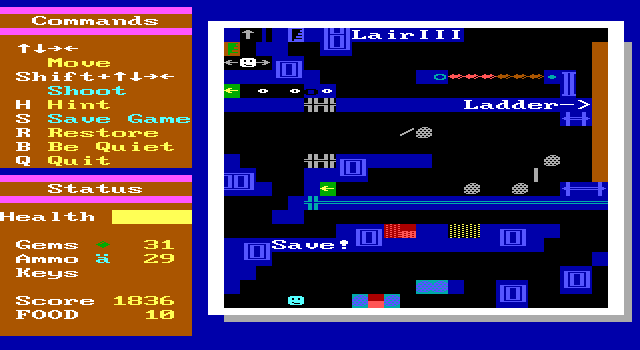
Any thoughts that this might be a particularly fast-learner are quickly thrown out the window upon ascending the Tower of Dratar. Once again the game mixes up how the player interacts with it, this time turning into a uniquely Super ZZT platformer! Once again you'll ask why it took so long for somebody to make a Super ZZT platformer, especially as ZZT ones typically reduce the play-space by a significant margin. As far as ZZT platformers go, 8x14 does it again. These micro-levels end up being some of the best designed levels I've seen of the style.
Orin can automatically walk up small ledges, with his larger leaps being fixed arcs. He can also shoot by pressing down to fire in the last direction eh moved. One minor frustration comes from always jumping in the last direction you moved as well, something that can require a bit of dancing on a ledge to properly position yourself. Aside from that though, the levels are designed for Orin's capabilities, avoiding the usual pitfalls of... pitfalls, or requiring a level of precision that can make things maddening. Orin can be harmed or killed to be sure, but 8x14 has made sure that the player won't die for mistiming a jump onto a moving platform. As far as grid-based platforming goes, the lack of malice shown towards the player is a welcome change.
Oh, and the engine is designed so that you can save in the middle of a level without worrying about soft-locking yourself by being unable to unpause after restoring a save.
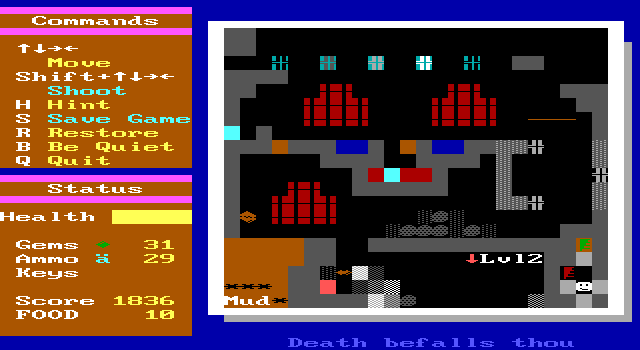
The levels themselves are quite pretty to look at too! Otherwise bare backgrounds are livened up with windows including some very clever usage of Super ZZT's web elements to divide panes of glass. Pools of acid bubble beneath brittle bridges that sag under Orin's weight, encouraging him to not dawdle for too long lest they collapse. The far more square looking characters in Super ZZT's usual display mode feel like a better fit for such an engine. Going from ZZT's nearly 2:1 aspect ratio on its characters to something much closer to 1:1 really balances things out. Having a more evenly spaced grid helps immensely when portraying Orin's jumping abilities in contrast to ZZT where you'll drop like a stone while horizontal movements feel restrained.
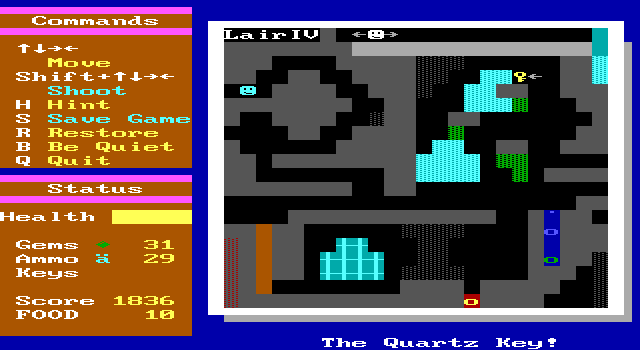
8x14 still has one more trick up his sleeve though. While the bite-sized single-screen platforming of the first three levels is perfectly fit for Super ZZT's fixed camera, 8x14 pushes the envelope even further with Super ZZT's first ever side-scroller that scrolls-sides! The final level is larger in scope, spanning the width of closer to four of the previous levels in width. Up to this point, everything Tyrobain threw at me may have been surprising, yet they were surprises I understood. Prior to encountering this scrolling stage, I didn't think that you could actually pull this off in Super ZZT even if you wanted to.
Alas, the scrolling here does fall victim to the kind of ZZT jank engines often run into. The scrolling is handled by having the player on the top of the screen and get pushed around as they move Orin left and right. If Orin should bump into a wall, the player will still slide which can actually cause some awkward camera troubles as the two desync. This can be dealt with by just bumping into a wall in the opposite direction, and can be used to actually position the camera as you see fit, letting you see far off ahead of Orin if you so choose. Unfortunately, the last part of the level is very "open" and so if your camera isn't well-positioned you won't be able to do anything about it.
Could it be done better? Perhaps, but not easily. The platforming section is once again entirely placed on a single board, and weighs in at more than 19,700 bytes of the 20,000 allotted to a standard Super ZZT board. Without breaking the level off into its own board there's not much wiggle room to try and clean up the camera a little, though I'd still have appreciated something like pressing "H" for Super ZZT"s hint system to center the camera by aligning Orin with the actual player element.
Minor camera woes aside, the platforming section of Tyrobain is undoubtedly its biggest surprise. This is absolutely the kind of engine that would have turned heads at the turn of the century, and is quite capable of impressing to this day.
One Word of Warning
As much as I want to praise this game, and as few as its flaws may be, there is one issue here. For whatever reason, it seems to struggle quite a bit to run towards the later dungeon segments. Both Zeta and DOSBox will randomly run into some nasty performance issues, requiring very slow and methodical movement to reach the end. In this state, other aspects may randomly break as well. My initial stream ran into issues with a player clone not properly being destroyed. Trying the game in browser via the Museum just now let to an outright hang of the game when exploring Atkar Woods. The 2016 release date for the game means that this is a game that was designed with DOSBox in mind (I mean, it's either that or playing it on a retro PC), but the issues persist there just the same. This does seem to be averted when running DOSBox on maximum CPU cycles rather than a fixed amount, but I have not tested this too thoroughly. (Enough to start from the Atkar woods, win an encounter, and progress far enough to pull a lever without any trouble.) Whatever the cause may be, it is worth doing whatever you need to to see the game through to the end if you've made it this far. If it's as simple as cycles=max in the DOSBox configuration file, that's ideal.
I ran into similar trouble originally with one of the RPG fights seemingly breaking as flags from several encounters ago hadn't been cleared properly resulting in flags overwriting each other. This may have been related to the slowdown issue. Needless to say, save frequently with multiple filenames once you begin to explore dungeons, in particular the Atkar woods. After that point I had no more issues, but my fingers were crossed the entire time.
The Campaign For Super ZZT
No single creative work deserves the burden of being used to judge the worth of a medium, but after thirty years of neglect, it's very hard to not look at Tyrobain and not then immediately recognize Super ZZT as a worthy alternative to ZZT after all these years. Let's explore some of these common criticisms and see how Tyrobain deals with them.
Argument: REMEMBBER TORCHES?? NOT IN SZZT
Rebuttal: While Super ZZT's viewport fits nicely in between the low-visibility of ZZT's torches and seeing an entire board in ZZT, 8x14 actually implemented their own torch engine for Tyrobain. Torches can be picked up and are tracked via a flag-based counter and can then be lit from the inventory menu displayed after pressing "H". Torches will reveal invisible walls while they're burning, allowing the player a chance to escape when they run out of torches rather than just being stranded in place with nothing to navigate by.
Argument: WHAT ABOUT SCROLLING???? WELL QUITE FRANKLY, SCROLLING SUCKS ANYWAY!!!!
Rebuttal: Okay, sure you could perhaps get away with redesigning the overworld for regular ZZT, and not lose too much. The overworld is broken up into enough distinct regions that adopting the landmass to ZZT-scale boards should be do-able. However, this doesn't really work with the dungeons. Systems like the torch engine could be done in ZZT, with or without the usual torches as well, but the timer just couldn't function as seamlessly between boards.
Argument: AND THE FACT THAT WHEN YOU MAKE IT, IT LOOKS COOL, BUT IT GETS ENLARGED ON SZZT.
Rebuttal: ZEXTAR.COM! Tyrobain uses this custom font designed specifically for the game, ensuring that all characters are 100% displayed how the author wanted them to be seen. Development would have had the opposite problem where the editor was what looked incorrect with the font.
Argument: AND IT'S A WELL KNOWN FACT THAT YOU CAN HAVE ABOUT 3 TIMES AS MANY BOARDS AS SZZT.
Rebuttal: Not wrong, but Tyrobain is a pretty hefty game in its own right. The initial stream of the game I did was more than five hours long, easily making it one of the longest (Super) ZZT games I've ever played. Plus, all that playtime is spent in a single file!
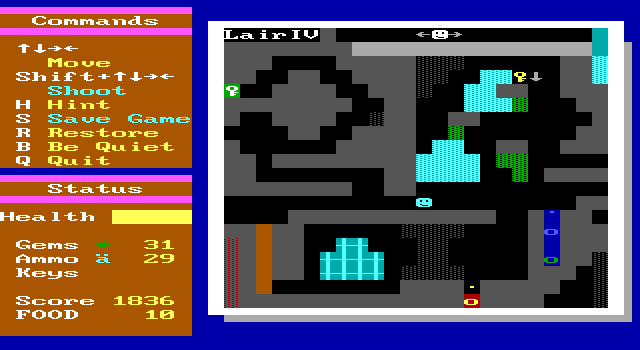
Argument: A LOT OF TRICKS DON'T WORK FOR SUPERZZT.
Rebuttal: A lot of Tyrobain's tricks don't work for regular ZZT! Its torch system, the scrolling platformer stage, balancing map/first-person navigation in dungeons, and the game makes nice use out of things like ZZT's water with its currents as well.
All kidding about the old campaign aside, Super ZZT genuinely has been very much ignored by the ZZT community for decades. What 8x14 has done with Tyrobain has really done quite a bit to shake loose any old perceptions of the engine's inferiority to the original ZZT. His skill here is undeniable. Tyrobain is a grand adventure that's wildly ambitious in showing just how much content can be crammed into so few boards. To have a Super ZZT game with even half of what Tyrobain includes is something long overdue.
Let it not be said though that Tyrobain is notable only because of its .SZT file extension. This is absolutely one of those games that transcends its Super ZZT label, offering a great experience to anybody simply looking for an indy-RPG. For those who grew up playing ZZT games with RPG engines (be they graceful inclusions or otherwise) or dungeon crawlers by the likes of Testa, Tyrobain brings those designs into the modern era. The front-facing aesthetics are shiny, while well-oiled machinery runs in the back resulting in a game that's immensely successful at creating a rock solid RPG experience today. Whether you're just curious about what potential has been hidden in Super ZZT all this time, interested in a newer ZZT RPG that can bypass the tedious engines and crude narratives of the past, or just want an RPG that can be finished in a few hours ASCII or otherwise, Tyrobain is an excellent way to do it.

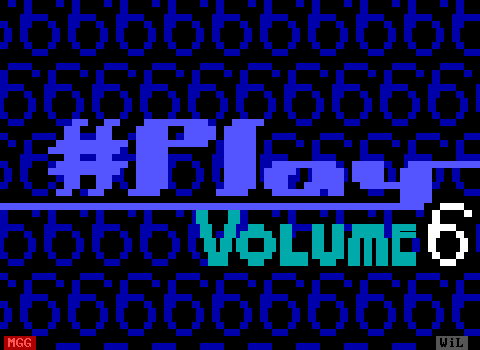





Argument: REMEMBER THIS [water]??? CAN'T GET THIS ON SZZT. THERE SO MANY WATER THINGS YOU CAN DO. AND THE SHARK???
Rebuttal: Obviously Super ZZT replaces water with lava. Still, Tyrobain features plenty of faux-ZZT water which thanks to color cycling
#changecommands, it actually looks quite nice. (The in-game animation loops more cleanly than this GIF.)